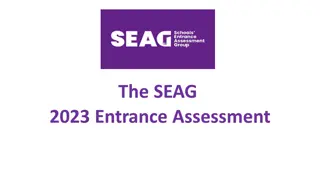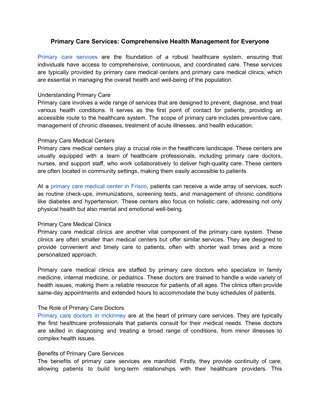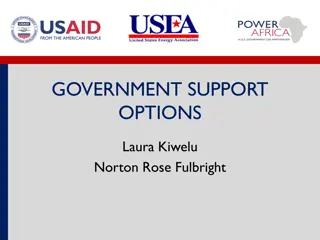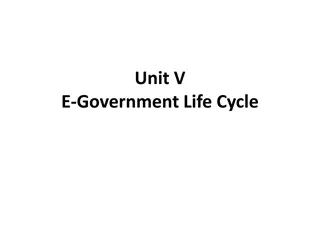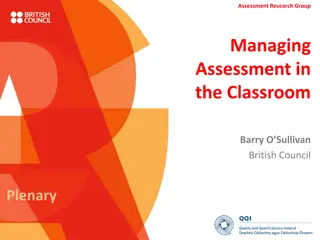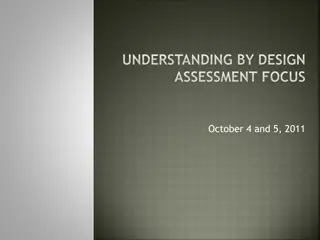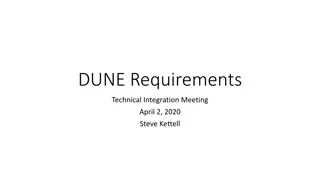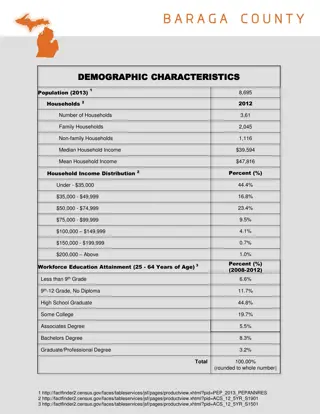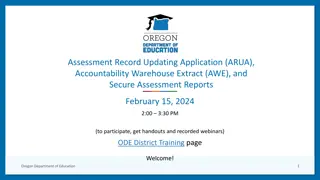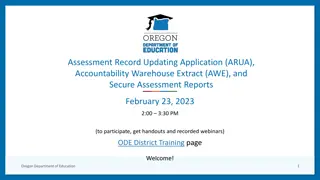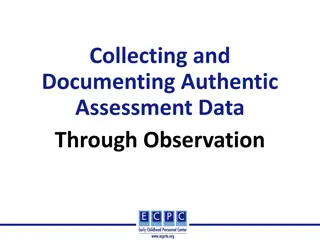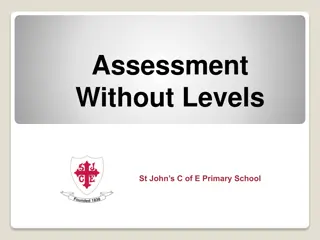Assessment in Primary PE - Understanding Government Requirements
Assessment practices in primary PE, gain insights into implementation strategies, benefits for pupils and teachers, and tools for development in schools. Covering national curriculum requirements and subject content for Key Stage 2.
Download Presentation

Please find below an Image/Link to download the presentation.
The content on the website is provided AS IS for your information and personal use only. It may not be sold, licensed, or shared on other websites without obtaining consent from the author.If you encounter any issues during the download, it is possible that the publisher has removed the file from their server.
You are allowed to download the files provided on this website for personal or commercial use, subject to the condition that they are used lawfully. All files are the property of their respective owners.
The content on the website is provided AS IS for your information and personal use only. It may not be sold, licensed, or shared on other websites without obtaining consent from the author.
E N D
Presentation Transcript
Assessment In Primary PE HELEN STEVENS POINTS LEARNING NETWORK
Background Trained as Secondary PE Specialist Worked in Secondary Education for 12 years, including HOD PE for 7 years Moderator for GCSE PE Examinations (Edexcel) for 8 years Worked as School Sports Coordinator for 9 years Worked as PE Consultant for SCC for 2 years Director of Points Learning Network for 9 years working with over 25 primary schools (ongoing) Lecturer for SHU on PGCE Secondary PE ITT Course for 10 years (ongoing)
Course Outcomes Understand the government requirements in relation to assessment in PE at primary level Gain a better perspective of the different ways assessment can be implemented in primary schools Have an insight into why assessment in PE can benefit pupils and teachers Be more confident about how assessment can be implemented / adapted in existing school Have the tools to develop assessment in PE at existing school
What Is Assessment? Assessment is defined as . the process of gathering, recording, interpreting, using and reporting information about a child s progress and achievements in developing knowledge, skills and attitudes (National Council for Curriculum and Assessment (NCCA) 2007, 7).
National Curriculum Requirements? Purpose of study A high-quality physical education curriculum inspires all pupils to succeed and excel in competitive sport and other physically-demanding activities. It should provide opportunities for pupils to become physically confident in a way which supports their health and fitness. Opportunities to compete in sport and other activities build character and help to embed values such as fairness and respect. Aims The national curriculum for physical education aims to ensure that all pupils: develop competence to excel in a broad range of physical activities (Hands) are physically active for sustained periods of time (Heart) engage in competitive sports and activities (Head) lead healthy, active lives (Heart) Attainment targets By the end of each key stage, pupils are expected to know, apply and understand the matters, skills and processes specified in the relevant programme of study.
NC PE Subject Content KS2 Key stage 2 Pupils should continue to apply and develop a broader range of skills, learning how to use them in different ways and to link them to make actions and sequences of movement. They should enjoy communicating, collaborating (head)and competing with each other. They should develop an understanding of how to improve in different physical activities and sports and learn how to evaluate and recognise their own success. Pupils should be taught to: use running, jumping, throwing and catching in isolation and in combination play competitive games, modified where appropriate [for example, badminton, basketball, cricket, football, hockey, netball, rounders and tennis], and apply basic principles suitable for attacking and defending develop flexibility, strength, technique, control and balance [for example, through athletics and gymnastics] perform dances using a range of movement patterns take part in outdoor and adventurous activity challenges both individually and within a team compare their performances with previous ones and demonstrate improvement to achieve their personal best
Reporting Requirements From September 2014 the old system of levels was largely removed from school assessment systems It was thought that levels did not truly reflect a child s performance and could oversimplify the process causing confusion The government requirement for schools with regards to PE is that progress is reported to parents
Assessment DFE Core Principles The DfE (2014) published a set of core principles that should underpin any approach to assessment in the National Curriculum (2013). It suggests effective assessment systems: Give reliable information to parents about how their child and their child s school is performing a. Allow meaningful tracking of pupils towards end of key stage expectations in the new curriculum, including regular feedback to parents. b. Provide information which is transferable and easily understood and covers both qualitative and quantitative assessment. c. Differentiate attainment between pupils of different abilities, giving early recognition of pupils who are falling behind and those who are excelling. d. Are reliable and free from bias.
DFE Core Principles (continued) Help drive improvement for pupils and teachers a. Are closely linked to improving the quality of teaching. b. Ensure feedback to pupils contributes to improved learning and is focused on specific and tangible objectives. c. Produce recordable measures, which can demonstrate comparison against expected standards and reflect progress over time. Make sure the school is keeping up with external best practice and innovation a. Are created in consultation with those delivering best practice locally. b. Are created in consideration of, and are benchmarked against, international best practice.
Why Assess? Teacher Perspective To enable secure and effective reporting Structure Awareness Consistency Motivation
Why Assess? Physical Education Consistency across assessment in school, PE is treated as any other subject Raises the profile of PE and acknowledges its worth as a subject
Why Assess? Children Less academic pupils can succeed in a subject Highlights to children the importance of PE as a subject Motivational tool for children Supports the timely development of physical literacy
Where Do I Start? Why am I assessing? What am I assessing? How am I assessing? How will I use my findings?
Where Do I Start? Curriculum A Consistent curriculum MUST be in place Without a consistent curriculum in place assessment will be: Ineffective Unreliable Inconsistent A waste of time
Curriculum Get Set 4 PE - https://www.getset4pe.co.uk/ Imoves - https://imoves.com/ PSSI - https://pssi.pdst.ie/ Val Sabin - https://www.valsabinpublications.com/
What Should Assessment Achieve? Often, assessment is used to prove whole school improvement, or we confuse assessment with recording and reporting. The most powerful assessment processes and systems do much more than that. They: have the learner at the heart are integral to teaching and learning are ongoing and not episodic provide a view of the whole learner allow comparisons to be made with other learners, subject areas and schools help the learner recognise their areas of strength and development support the learner to identify how to improve give a school, department and teacher a rounded view of a learner enable teachers to shape their teaching so that they meet every learners need allow judgements to be made against the subject content at each Key Stage of the PE National Curriculum (where appropriate) Frapwell, A. (2010). Developing a Coherent Secondary Physical Education Curriculum. [afPE, sports coach UK, Youth Sport Trust (Consortium)]
The Process of Assessment Assessment at its most simplest is: Establishing WHERE learners are in their learning Establishing WHERE they are going Working out HOW to get there Dylan Williams
Formative vs Summative A balance between these two types of assessment methods is needed Summative assessment often dominates Formative assessment is the tool to improve the summative assessment This is where a clear, coherent and progressive curriculum is essential
The 3 Is Intent Implementation Impact
Where Do I Start? 468 hours of Physical Education from Year 1 - 6
Where Do I Start? Useful Tools Assessment Tool 1 What does our class look like? A simple assessment tool. (Formative and Summative) This assessment sheet is designed as a start point to consider the strengths and areas for development of pupils within your class. Most children if not all, will fit into one of the categories with ease, although this may vary with certain activities where children exc This tool is designed not as a way of necessarily tracking progress, but to consider how you might approach the way you teach different groups within the class and how you might group pupils to get the maximum progress out of them. This sheet should be used alongside other assessment tools.
Where Do I Start? Assessment Tool 1 1. Very sporty, physically literate, often academically strong, transferable skills across most sports, leadership material. 2. Sporty in one or two areas, probably football, not necessarily highly intelligent, easily bored, rush around, poor listeners. 3. Low self-esteem and / or confidence, compliant, possibly low motivation or reluctant, works well in team, might be able to articulate what they need to do but can t necessarily do it. 4. Poor spatial awareness, balance and coordination, poor core strength, low confidence, possibly SEND.
Where Do I Start? Assessment Tool 1 (cont d) 1. Very sporty etc Ensure mental and physical challenge, Officiating, Leadership, coaching skills, Independent learning, Vary activity, scenario or environment to assist challenge. School Teams. 2. Sporty in one or two areas etc Encourage decision making opportunities, mental challenge, articulation skills, coaching skills and improved concentration and listening skills. 3. Low self-esteem etc Ensure achievable targets to build confidence, environment is non- threatening, engagement is encouraged, team building. Outdoor learning and creative activities may appeal. 4. Poor spatial awareness, SEND etc Ensure achievable targets, basic movement skills are mastered, non- threatening environment, confidence built, PE intervention is targeted here. Outdoor learning may appeal.
Where Do I Start? Be Realistic Choose an assessment and recording system that is manageable (Ideal vs Get Real?) Will all staff buy into it? Is it workable? Introduce it gradually to build confidence Trial it yourself or with a small number of teachers first? Review the trial and make necessary adjustments
Assessment Tool 2 - 7 Screen share
Assessment - Do and Donts! Do ensure that there is a clear curriculum map and curriculum content that all staff are following Do ensure that the method of assessing and recording is manageable and productive Do ensure that assessments are ongoing (formative) as well as summative(reporting) Do ensure that assessments follow the 3 I s Do find a best fit for the way in which assessments are carried out e.g. a child that is good at football may still not be well developed in gymnastics or swimming Don t simply assess by grading individual sports, these should form part of a bigger picture of overall assessment of physical literacy Do make sure that assessment information is passed on to teachers of children across the school
Assessment Supporting Staff Ensure teachers know how they can support emerging learners in their classes Encourage STEP Principle to differentiate in lessons i.e. Space, Time, Equipment and People Encourage demonstrations so that children know what is required Use questioning (both open and closed) to assess pupils understanding Ensure that stretch and challenge allows more able pupils to stay motivated Use of conditioned games to encouraged width and spacing Encourage Peer Assessment as a useful tool to assist children in their understanding of what is required
Assessment Using Peer Assessment Peer assessment is a valuable tool provided you are clear about what you want the observer to look for. Context of Lesson The lesson in which the peer assessment is taking place, involves exploring travelling using one footed and two footed landings and take-offs. Pupils are encouraged to use their arms for balance and extra height and then to land with squashy knees. The overall aim is control. Observers are asked to watch and say what they did well and how they could improve. The sheet is designed to be used for any similar activity where the teacher outlines what the criteria for assessment is. The sheet is only effective is the criteria is clear and pupils are encouraged to discuss their findings with their partner and the class. This can be followed up with more open ended questions such as why was that successful? , How can it be improved? , Which sports do you think this skill might be useful in and why? and so on.
Assessment Using Peer Assessment Share Screen Tool 6
What The Experts Say! The following statement and guidance has been developed by members of the Physical Education Expert Group and highlights key assessment principles outlined in the publication Assessment Principles (DfE, 2014). Effective assessment in physical education engages supports and motivates pupils to become competent, confident, creative and reflective movers. It can support and encourage young people to work together in order to excel in physically demanding and competitive activities. Approaches to assessment must be meaningful and embedded throughout a high quality physical education curriculum; which enables learners to make progress and improve their attainment. Although locally determined and child-centred, physical education must be situated within a whole school approach to assessment and support a child s development across the whole curriculum.
Summary What A Child Should Expect! Assessment and recording system that is manageable Ongoing Assessment that supports learning Consideration of the 3 I s Child-centred
Useful Links https://www.afpe.org.uk/physical-education/wp- content/uploads/Head-Hands-Heart-Web.pdf https://www.afpe.org.uk/physical-education/wp- content/uploads/A-Simple-Guide-to-National-Curriculum- Progression-in-Physical-Education-Web.pdf https://www.youthsporttrust.org/system/files/resources/documents/ Assessing_Without_Levels.pdf https://www.afpe.org.uk/physical-education/wp- content/uploads/Physical_Education_Assessment_booklet_revised_J une_2015.pdf
Questions Any questions?
Contact Get In Touch! Helen Stevens hcstevens@btinternet.com


